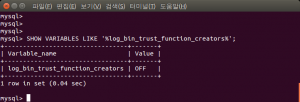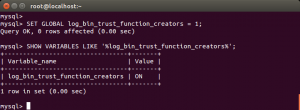 Note: There is an updated post on this topic here.
Note: There is an updated post on this topic here.
I recently stumbled upon a post that Peter Zaitsev published back in 2007 titled “Innodb Performance Optimization Basics.” It’s a great post and reading it inspired me to examine what’s changed in the nearly six years that have followed in terms of MySQL, Percona Server – as well as in all of the other now-available infrastructures.
And a lot has in fact changed! In this post I am going to highlight most of the InnoDB parameters critical for InnoDB – specifically from a performance perspective. I’m a support engineer and I can tell you that Percona Support gets many questions related to the right sizing of basic InnoDB parameters.
So hopefully this post will help others with similar questions and issues.
Hardware:
For larger datasets, nowadays memory counted in hundreds of giga- and even in terabytes is not surprising. MySQL requires significant memory amounts in order to provide optimal performance. By caching hot datasets, indexes, and ongoing changes, InnoDB is able to provide faster response times and utilize disk IO in a much more optimal way. From a CPU standpoint, faster processors with many cores provide better throughput. CPUs with 32/64 cores or more are becoming common now, and the latest MySQL versions are able to utilize them much better then before. In terms of storage, SSD disks are replacing traditional spindles with great success, offering the best performance for the money. RAID 10 is still the most recommended level for most workloads, but first make sure your RAID controller is able to utilize the SSD drive’s performance and will not become the actual bottleneck. There are also many PCI-e Flash drives out there if you need even more IOPS.
Operating System:
Linux is the most common operating system for high performance MySQL servers. Make sure to use modern filesystems, like EXT4 or XFS on Linux, combined with the most recent kernel. Each of them has it’s own limits and advantages: for example XFS is fast in deleting large files, while EXT4 can provide better performance on fast SSD drives. Benchmark before you decide. Check this blog post to see how EXT4 can outperform XFS. You can use noatime and nodiratime options if you’re using innodb_file_per_table and a lot of tables though benefit of these is minor. The default I/O scheduler in Linux is Completely Fair Queuing (CFQ), while Noop/Deadline will be much better in most cases.. Setting swappiness to zero is generally recommended for the MySQL dedicated host, which will lower the tendency of swapping. Make sure the MySQL host does not run out of memory. Swapping is bad for MySQL and defeats the purpose of caching in memory. To learn more about swapping, check this blog post
MySQL Innodb Settings
From 5.5 InnoDB is the default engine, so these parameters are even more important for performance than before. The most important ones are:
- innodb_buffer_pool_size: InnoDB relies heavily on the buffer pool and should be set correctly, so be sure to allocate enough memory to it. Typically a good value is 70%-80% of available memory. More precisely, if you have RAM bigger than your dataset setting it bit larger should be appropriate with that keep in account of your database growth and re-adjust innodb buffer pool size accordingly. Further, there is improvement in code for InnoDB buffer scalability if you are using Percona Server 5.1 or Percona Server 5.5 You can read more about it here.
- innodb_buffer_pool_instances: Multiple innodb buffer pools introduced in InnoDB 1.1 and MySQL 5.5. In MySQL 5.5 the default value for it was 1 which is changed to 8 as new default value in MySQL 5.6. Minimum innodb_buffer_pool_instances should be lie between 1 (minimum) & 64 (maximum). Enabling innodb_buffer_pool_instances is useful in highly concurrent workload as it may reduce contention of the global mutexes.
- Dump/Restore Buffer Pool: This feature speed up restarts by saving and restoring the contents of the buffer pool. This feature is first introduced in Percona Server 5.5 you can read about it here. Also Vadim benchmark this feature You can read more about it in this post. Oracle MySQL also introduced it in version 5.6, To automatically dump the database at startup and shutdown set innodb_buffer_pool_dump_at_shutdown & innodb_buffer_pool_load_at_startup parameters to ON.
- innodb_log_file_size: Large enough InnoDB transaction logs are crucial for good, stable write performance. But also larger log files means that recovery process will slower in case of crash. However this is not such big issue since great improvements in 5.5. Default value has been changed in MySQL 5.6 to 50 MB from 5 MB (old default), but it’s still too small size for many workloads. Also, in MySQL 5.6, if innodb_log_file_size is changed between restarts then MySQL will automatically resize the logs to match the new desired size during the startup process. Combined log file size is increased to almost 512 GB in MySQL 5.6 from 4 GB. To get the optimal logfile size please check this blog post.
- innodb_log_buffer_size: Innodb writes changed data record into lt’s log buffer, which kept in memory and it saves disk I/O for large transactions as it not need to write the log of changes to disk before transaction commit. 4 MB – 8 MB is good start unless you write a lot of huge blobs.
- innodb_flush_log_at_trx_commit: When innodb_flush_log_at_trx_commit is set to 1 the log buffer is flushed on every transaction commit to the log file on disk and provides maximum data integrity but it also has performance impact. Setting it to 2 means log buffer is flushed to OS file cache on every transaction commit. The implication of 2 is optimal and improve performance if you are not concerning ACID and can lose transactions for last second or two in case of OS crashes.
- innodb_thread_concurrency: With improvements to the InnoDB engine, it is recommended to allow the engine to control the concurrency by keeping it to default value (which is zero). If you see concurrency issues, you can tune this variable. A recommended value is 2 times the number of CPUs plus the number of disks. It’s dynamic variable means it can set without restarting MySQL server.
- innodb_flush_method: DIRECT_IO relieves I/O pressure. Direct I/O is not cached, If it set to O_DIRECT avoids double buffering with buffer pool and filesystem cache. Given that you have hardware RAID controller and battery-backed write cache.
- innodb_file_per_table: innodb_file_per_table is ON by default from MySQL 5.6. This is usually recommended as it avoids having a huge shared tablespace and as it allows you to reclaim space when you drop or truncate a table. Separate tablespace also benefits for Xtrabackup partial backup scheme.
Along with that, there are lot of enhancements for InnoDB, specifically in Percona Server 5.5 and in Oracle MySQL 5.6. Persistent optimizer statistics is one of the features first introduced in Percona Server 5.5 that requires the enabling of the innodb_use_sys_stats_table in XtraDB. You can read more about it here. This feature is now included in Oracle MySQL 5.6, too. In MySQL 5.6 persistent stats are stored in two new tables: mysql.innodb_index_stats and mysql.innodb_table_stats. Through this query plans are much more accurate and consistent. You can read more about it in documentation. Also Percona Server 5.5 introduced a Thread Pool feature which is ported from MariaDB. You can read more about it in this documentation. On a related note, I recommend reading this blog post from Vadim on the Thread Pool feature.
Percona Server free and open source. An enhanced drop in Oracle MySQL replacement and some of the mentioned features are only applicable to Percona Server.
There are bunch of other options which you may want to tune but in this post we focus only InnoDB specifically.
Application tuning for Innodb:
Especially when coming from a MyISAM background, there will be some changes you would like to make with your application. First make sure you’re using transactions when doing updates, both for sake of consistency and to get better performance. Next if your application has any writes be prepared to handle deadlocks which may happen. Third you should review your table structure and see how you can get advantage of Innodb properties – clustering by primary key, having primary key in all indexes (so keep primary key short), fast lookups by primary keys (try to use it in joins), large unpacked indexes (try to be easy on indexes).
Conclusion:
We covered almost all basic and important InnoDB parameters, OS related tweaking and hardware for optimal MySQL server performance. By setting all mentioned variables appropriately certainly help to boost overall MySQL server performance.
More Resources
Posts
- How to Choose the MySQL innodb_log_file_size
- Here’s my favorite secret MySQL 5.6 feature. What’s yours?
- What is a big innodb_log_file_size?
- How to change innodb_log_file_size safely
- Measuring the amount of writes in InnoDB redo logs
eBooks (free to download)
Database Tools
'DB TUNE' 카테고리의 다른 글
| MySQL stored procedure permission control (0) | 2018.05.05 |
|---|---|
| MySQL 기본 스토리지 엔진 변경 (0) | 2018.05.04 |
| MySQL 현재 접속자 보기 및 MYSQL 모니터링 방법 (0) | 2018.04.26 |
| [MySQLD] Tunner (0) | 2018.04.19 |
| [MySQLD] innodb_file_per_table (0) | 2018.04.19 |


